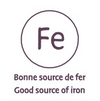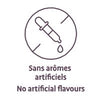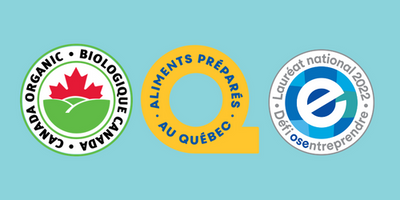Beef meal
For Quebec and Ontario: Delivery is $9.99 or free with purchases of $125 or more!
For the Maritimes: Delivery is $14.99 or reduced to $9.99 with purchases of $125 or more!
Product Features
Textured and nutritious meal bursting with flavour and colour
Frozen ready to be reheated
Made with 8 nutritious ingredients
No artificial flavors or preservatives
No added salt or sugar
Good source of iron
Just like homemade
The recommended introductory age of 9 months and older is based on the normal development of a baby's oral-motor skills.
You can adapt the texture according to your baby's development: pureed, crushed or in small pieces. Thus, the age of introduction can vary according to the chosen texture.
* Always stay close to baby when feeding.
** Please note that it is important to have introduced the different allergens individually before offering our meals containing a variety of ingredients.
Ingredients
Cooked lean ground beef, Cooked medium brown rice, Carrots, Curly kale, Crushed brown flax seeds, Shallots, Olive oil, Herbs.
Preparation method
Stovetop (RECOMMENDED): In a saucepan, add the desired amount of the meal and an equivalent amount of water. Bring to a boil. Stir and lower heat. Simmer for 5 minutes, stirring occasionally.*
Microwave: In a microwave-safe container, add the desired amount of the meal and a little water, if necessary. Reheat in 15-second increments. *
* Allow to cool and stir. Always check the temperature of the food before serving it to your baby. Discard leftovers. Store the unthawed portion in the freezer until needed.
A complete and nutritious diet can help your child reach key developmental milestones
Belov is here to help you: Simplify mealtime, impart healthy eating habits from the first bites, and help your little one develop optimally. That's what Belov is all about!
A balance of different vegetables, a protein and a grain to which are added a few ingredients to spice up the flavours and add nutrients!
A list of ingredients that will reassure you as a parent! No added sugar or salt, no additives or preservatives.
Meal FAQs
What is deep-freezing?
Deep-freezing is a process that maximizes the preservation of nutrients, color, taste and odor by bringing food to freezing point much faster than a traditional freezer.
The preservation of meals is optimized and allows us to offer a practical solution with complete peace of mind.
How is it possible to have no water in the ingredient list of your meals, when it is almost always an ingredient in prepared baby food?
Before we even started creating the meals, we scoured the comments of a variety of baby food manufacturers and retailers to see what parents had to say about the current products on the market. Like them, we were shocked by the list of ingredients in some of the products that were presented as "nutritious".
Many parents questioned the nutritional quality of purees and meals where water was listed as the first ingredient (ingredients are listed in order of quantity used in the product). Water is essential, we all agree, but it is not nutritious.
It then became part of our mission to offer meals without added water!
Finally, as suggested by Canada's Food Guide, make water your drink of choice :)
Your meals contain a few priority allergens, have you thought about that?
OH YES! Laurie herself is allergic to peanuts, nuts (with a few exceptions), mollusks and previously to lentils and bovine protein to name a few of her food allergies...
Allergies are part of her daily life and the one thing she wishes to not pass on to her eventual children is her allergies!!! She compares allergies to a predator that follows her everywhere she goes.
Recent studies have shown that the risk of developing allergies does not decrease by delaying the introduction of allergens, quite the contrary. Studies conducted over the past decade suggest that early introduction of allergenic foods can prevent food allergies in high-risk infants. For this reason, we did not hesitate to introduce salmon, edamame (soy), beef (bovine protein), chickpeas and lentils. Please note that it is important to have introduced the different ingredients individually before offering our meals containing a variety of foods.
Consult your doctor before introducing allergens to your baby.
At what age can I start offering your meals to my baby?
The recommended age of introduction on our packaging, 9 months and up, is based on the normal development of a baby's oral-motor skills. That being said, our meals are versatile! You can adapt the texture according to baby's development: puree, mashed or in small pieces. The age of introduction can vary depending on the texture chosen! Please note that it is important to have introduced the different ingredients individually before offering our meals with a variety of foods.
Consult your doctor before introducing complementary foods to your baby.
Why is there no fruit in your meals?
First of all, let's not start the tomato debate! We are well aware that the tomato is a fruit, but it is eaten as a fruit-vegetable, raw or cooked.
As mentioned in the answer to the question How is it possible to have no water in your ingredient list when it is almost always an ingredient in prepared baby food? Before we even started creating the meals, we scoured the comments of a variety of baby food manufacturers and retailers to see what parents had to say about the current products on the market.
We are also very aware that fruit are ubiquitous in baby food products. Yet many parents expressed their concern about having fruit in all baby products offered, even in prepared meals such as chicken casseroles and beef stews. The source of their concern is that having fruit in meals contributes to developing their baby's sweet tooth. Instead, babies should be taught to enjoy the taste of vegetables without the addition of a sweet food!
Of course, fruit is great for your little one's health, but let's not forget the super antioxidant and nutritional power of vegetables! For these reasons, it was very important to us that our meals contain only vegetables and instead encourage parents to give fruit as a side dish at lunch, snack or dessert.
Your meals are said to be complete, what does this mean?
As outlined in the new version of Canada's Food Guide in 2019, the importance of enjoying a variety of healthy foods EVERY DAY - vegetables and fruits, whole grains and protein - has been emphasized.
Since we are committed to meeting the highest nutritional standards to contribute to the optimal development of your little one, we have ensured that each of these three components is included in all our meals. Thanks to this formulation, each bite is complete!
Have you considered offering your meals in portions?
ABSOLUTELY!! During our different tasting phases with baby tasters, we asked parents to measure the portion consumed by the baby. Our objective was to determine an optimal weight in order to offer our meals in set portions!
Well dear parents, you won't be surprised to read that there is NOTHING more variable than a baby's appetite, not even the weather! It's not just about the appetite of one baby versus another. NO!! The same baby can have a completely different appetite from one day to the next! This variability can be explained, among other things, by: the quantity of milk ingested during the day and night, the quality of sleep, the size of breakfast and snacks, the age, the stage of growth, their mood, their teeth, the quantity of water ingested during the meal, whether they are voracious eaters...
After several brainstorms, we concluded that THE optimal solution was to let parents portion the meal themselves. The GOOD NEWS is that our meals are easy to portion because they are not filled with water (so they are not a block of ice!!). The desired amount is easily portioned with a spatula, spoon or knife, or whatever you have on hand!
PRO tip: We recommend starting with a small portion and adjusting if the amount proves to be insufficient. This way, food waste is avoided 😊 Don't forget to put the unthawed portion back in the freezer until the next meal!!!
How many meals does one product equal?
As mentioned in the previous question " Have you considered offering your meals in portions? It was impossible for us to determine a precise quantity that would answer every baby's needs. For example, a 9-month-old baby may eat 25 grams, just as a 6-month-old baby may eat the same amount. Several factors influence the appetite of our adorable babies (many examples above!!) In doing so, it is your baby's appetite that will determine the number of meals per tray.
Even today, Flavie, soon to be 3 years old, devours Belov on a daily basis. That's right, our meals are nutritious, even for children of her age and let's face it, 24 hours in a day is not ENOUGH 😅 At her age, she sometimes eats half, sometimes three quarters of the tray, all depending on her appetite!
Are your meals dedicated to baby-led weaning (BLW)?
Our meals are dedicated to ALL Quebec infants REGARDLESS of the parent's preferred method. Our goal is to offer healthy and tasty foods, without separating children according to one approach or another. Each method has its advantages (and disadvantages!!) and what is important, FIRST AND FOREMOST, is that your baby has all the essential nutrients for his or her proper development.
It is important to note that even with the baby-led weaning approach, purees are part of baby's diet and even with the traditional approach, pieces are part of baby's diet! Most of us associate baby-led weaning with chunks and traditional feeding with purees when in fact, what distinguishes one method from the other is if babies bring the food to their mouth themselves, rather than with the help of mom or dad. If baby uses a spoon to eat yogurt or applesauce, that's baby-led weaning! At a few months old, they probably won't have the elegance of royalty with their spoon, but they'll be just as cute!
Finally, don't feel guilty about having a personalized approach! In reality, babies' observation must be prioritized and ultimately we must adapt to them! Let's keep in mind that the most important thing is to make sure that babies get all the essential nutrients for their development through nutrition, which plays a key role in this regard! Let's not forget that iron-rich foods are essential!
Why do you leave the peel on most vegetables in meals?
We have all heard that vegetables should be peeled before eating them. This recommendation, which seems legitimate, is not always necessary! You have to look at the nutritional quality of vegetable peels to understand the reasoning behind it. For most vegetables (and even fruits!), the peel is full of micronutrients in MUCH greater proportion than the flesh itself. In fact, vegetables (and fruits!) are composed mainly of water, some even 95% water. For example, the peel of an eggplant contains fiber, flavonoids and magnesium, while the flesh has a water content of about 90%! So, by keeping the peel on the vegetables, the nutrient intake is more significant! That being said, it is true that for some babies, the peel of vegetables can be more difficult to manage. Therefore, it is important to be vigilant and follow your child's skill development to determine their ability to eat a meal with vegetables and their peels.
Refer to your doctor before introducing vegetables with peels to your baby.
Why is texture emphasized in each of your product lines?
First of all, our greatest desire is to be your NINJA ally each and every day. In other words, to help you as a parent, for as long as possible and not let you down by offering a solution that becomes obsolete too quickly! In order to be a nutritional ally on a daily basis, we had to offer products that would be adequate for babies as early as possible in their development and that would continue to be nutritious for their constantly changing needs.
That being said, it is true that texture preference is unique to each individual, ALL TASTES are in nature, we say! Our intention is to offer nutritious meals to all little ones, so the good news is: OUR MEALS ARE VERSATILE! You can offer them in their original form that being chunks, or adapt the texture according to baby's preference and skill development: mashed or pureed. We can't say it enough, each baby is unique and you have to listen to their needs, rather than imposing one or the other texture (small pieces, mashed, puree).
We promote the word textured on our packaging but we are actually referring to ALL textures, as long as the chosen one is suitable for baby 😊 The introduction to different textures should be safe and enjoyable for our tiny tots.
When it comes to our oat flake blends, we wanted to offer babies the comforting experience of a more traditional oatmeal! What's more, Belov is committed to innovation! Putting another traditional cereal on the shelves, that we could call "powdered", was not in line with Belov's mission. Our tasty blends can even be added to baby's favorite preparations: muffins, pancakes, etc.! OHH YESSS! By being iron-fortified, we help you contribute to the recommended daily intake! OHHH WOOOWWWW!
Until what age can I offer your meals?
The target age for our products is 6 to 24 months. This period includes the introduction of complementary foods and extends to the end of the crucial first 1000 days of life (including the duration of pregnancy). This phase is crucial for the health of an individual and is the ideal opportunity for a parent to offer all the benefits of a healthy and varied diet! Moreover, during the first months of a child's life, it is not recommended to add salt or sugar to mini's meals (WHO, 2009) and our products are aligned with this. Hoorayyy!
On our packaging, the recommended age of introduction is 9+ months, but the texture can be adapted for an early introduction (refer to the question " At what age can I start offering your meals to my baby?")
Truth is that our products can also support the nutritional needs of young children, in fact even those of adults. Obviously, we are aware that the size of our products is a little too small for an adult, however, we encourage you to taste the "Belov" difference, you will be pleasantly surprised by the quality and flavour of our products. It's our promise neither baby nor you will make a face!
Consult your doctor before introducing complementary foods and to validate the nutritional needs of your baby.
Why do you recommend using the stovetop rather than the microwave?
We prefer the stovetop method for several reasons!
First, we were informed of the toxicity of using certain materials when heated. Although some plastics are advertised as "microwave safe", particle migration can still occur... This is all quite complex, so for the rest, let's channel our inner scientist!!!
There are several types of plastic and each has its own melting point. However, even if the melting point of a plastic, for example PET, is 255°C, the particles that make it up move when it is heated. Think you are being safe when heating plastics at home? Keep in mind that when you microwave food in any plastic container, its temperature increases and the particles forming it get agitated. This can cause those particles of plastic to actually migrate into the food. Not very REASSURING let's face it...
Since this information is not readily available to the general public (we needed a chemistry lesson to figure it all out haha), we prefer to rely on stovetop cooking. That way, we avoid contributing to increased exposure to plastic particle migration in baby food. HOWEVER!!! If you use a glass or porcelain container to microwave baby food, rest assured, there is no potential particle migration for these materials 😊
The second and much simpler reason we prefer this method is for the final result that can be obtained! The food will have simmered slowly over low heat for a few minutes, allowing all the ingredients and flavours to meld beautifully!
What's more, you'll notice that the aroma released is all the more amplified and how pleasant it is for everyone inside the home ! Lastly, maybe it's just us, but using a small pan and stirring a few times during cooking gives us the feeling of having spent hours preparing this delicious baby meal, IT'S LIKE A REWARD!!! Keep it simple 😉
Why do you suggest adding water when cooking?
This suggestion was added to the stovetop method to prevent the meal from sticking to the bottom of the pan. When the ingredients thaw, the surface in contact with the bottom of the pan could BURN! Your baby may not be able to talk, but he will communicate his lack of appreciation if you serve him a burnt meal! By adding water, the ingredients can slowly thaw and then simmer to give baby a smooth and delicious meal 😊 As suggested on our packaging, you can even substitute the water with any other binding agent: broth, sauce, vegetable puree, etc. Of course, the choice must be without added salt or sugar! Also, parents who decide to introduce our meals before 9 months can make it easier to manage the different textures by adding more of the chosen binding agent or even mash the meal with a fork or puree it.
Regarding the microwave preparation method, the addition of the binding agent is optional depending on the power of the microwave and obviously on baby's ability to handle the pieces as they are or to prioritize a different texture (mashed or pureed). For example, if you wish to offer the meal mashed, the addition of water or any other binding agent will allow you to obtain a smoother texture!
The important thing to remember is that as a parent, YOU are your baby's BEST OBSERVER 😊 Each child is unique and so is their development. The progression to textures can be a scary step for the parent, slowly but surely is the best way to go! If you want to gradually offer granular textures to baby and eventually transition to pieces without binding agents, that's fine too! Remember, the most important thing is not the method or texture, but that baby gets all the nutrients he needs to thrive!







